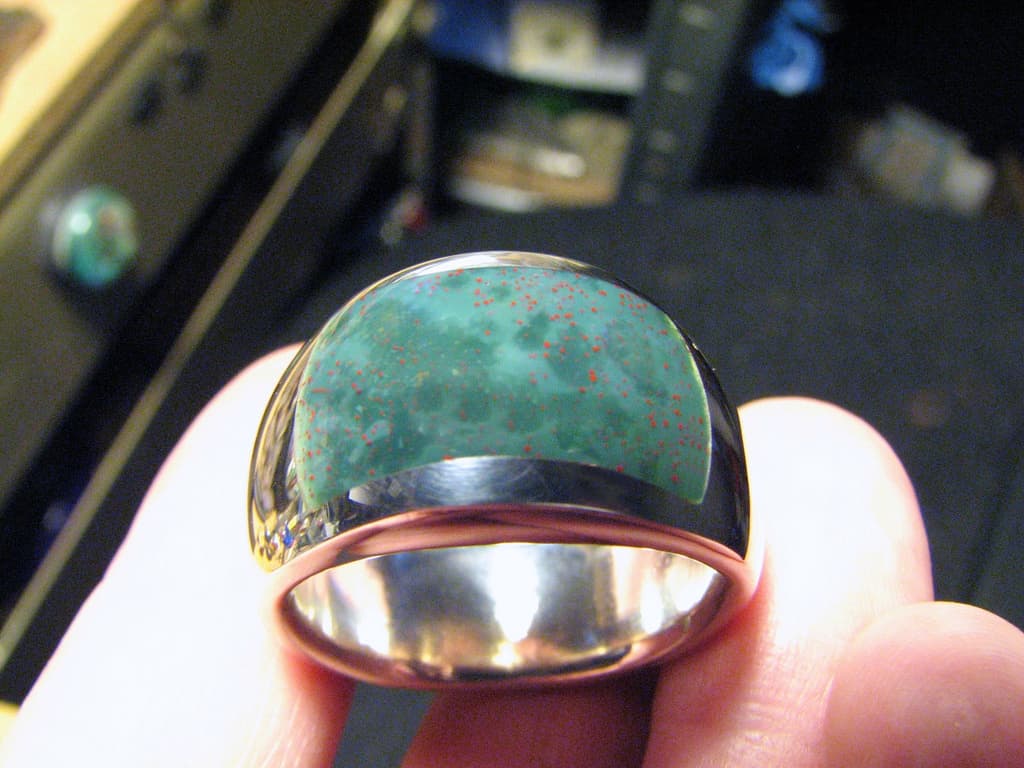Bloodstone Value, Price, and Jewelry Information
Also known as heliotrope, bloodstone is the traditional March birthstone. This dark green, opaque chalcedony with red to orange spots is a variety of plasma gemstone.
2 Minute Read
Also known as heliotrope, bloodstone is the traditional March birthstone. This dark green, opaque chalcedony with red to orange spots is a variety of plasma gemstone.
Start an IGS Membership today
for full access to our price guide (updated monthly).Bloodstone Value
Bloodstones are relatively inexpensive gems available in many sizes. The color and number of their spots play the primary role in their value. Stones with a greater number of deep red or dark orange spots usually sell for higher prizes. Of course, the artistry of the lapidary also contributes to the value of a piece.
Does Bloodstone Make a Good Jewelry Stone?
Although bloodstones can be faceted, they are more often cabbed or carved. Like other members of the quartz family, the stone's hardness makes it an excellent choice for a jewelry stone. The combination of deep green and blood red results in a visually striking material.
What Does Bloodstone Symbolize?
Bloodstones have developed a rich folklore throughout the centuries, particularly through sympathetic associations with blood. For example, the mineralogist and folklorist George F. Kunz relates how these gems have been considered particularly effective against hemorrhages.
Bloodstones have also come to symbolize bravery, perhaps through their associations with blood, vitality, and the Roman god Mars. Bloodstone is the traditional birthstone for March, the month named after this god of war.
Due to the blood-like appearance of bloodstone's spots, Christians in the Middle Ages also popularly associated the gem with martyrdom and the crucifixion of Christ.
Identifying Characteristics
Bloodstone's body color is darker than fellow green chalcedonies such as chrysoprase and prase. Bloodstone's opacity is caused by inclusions of actinolite or hornblende needles.
The red to orange spots distinguish bloodstones from plasma gemstones. The presence of iron oxides, such as hematite, cause these spots. However, some bloodstones may have few or no such spots.
Imitation Bloodstones
Although no synthetic bloodstones are known, gem buyers may encounter imitations or simulants. In particular, glass pieces can mimic bloodstone's colors. For example, the Japanese glass manufacturer Iimori has produced a green "maple stone" with red "flowers" that resembles bloodstone. However, despite appearances, glass and bloodstones have very different properties. A microscopic analysis reveals the "flowers" differ significantly from bloodstone spots.
Sources
Currently, India is the largest producer of bloodstones. Many localities in the United States produce this gemstone, principally in California.
Other notable gem-quality sources include the following:
- Australia; Brazil; Bulgaria; Canada; Czech Republic; Germany; Italy; Poland; Romania; Slovakia; South Africa.
Bloodstone Trade Names
Please note that chicken-blood stone and bloodstone are distinct gem materials.
"Blood Jasper"
Although opaque, single color, oxide-stained chalcedonies are usually considered jaspers, bloodstone isn't typically included in that category. It lacks the grainy structure also characteristic of jaspers.
"Oriental Jasper"
Another example of a "jasper" name, this one tries to glamorize a familiar gem with an exotic association. Unfortunately, you can find many examples of this misleading naming practice that attempts to "exoticize" familiar gemstones.
How to Care for Your Bloodstone Jewelry
With no cleavage, a hardness of 6.5 to 7, and tough tenacity, bloodstones make excellent gemstones for any jewelry type. Thus, this gem requires no special care and can handle mechanical cleaning. Nevertheless, mild detergent, warm water, and a soft brush are a good choice for cleaning.
Joel E. Arem, Ph.D., FGA
Dr. Joel E. Arem has more than 60 years of experience in the world of gems and minerals. After obtaining his Ph.D. in Mineralogy from Harvard University, he has published numerous books that are still among the most widely used references and guidebooks on crystals, gems and minerals in the world.
Co-founder and President of numerous organizations, Dr. Arem has enjoyed a lifelong career in mineralogy and gemology. He has been a Smithsonian scientist and Curator, a consultant to many well-known companies and institutions, and a prolific author and speaker. Although his main activities have been as a gem cutter and dealer, his focus has always been education.
International Gem Society
Related Articles
Sarcolite Value, Price, and Jewelry Information
Ludlamite Value, Price, and Jewelry Information
Lepidolite Value, Price, and Jewelry Information
Zektzerite Value, Price, and Jewelry Information
Never Stop Learning
When you join the IGS community, you get trusted diamond & gemstone information when you need it.
Get Gemology Insights
Get started with the International Gem Society’s free guide to gemstone identification. Join our weekly newsletter & get a free copy of the Gem ID Checklist!




